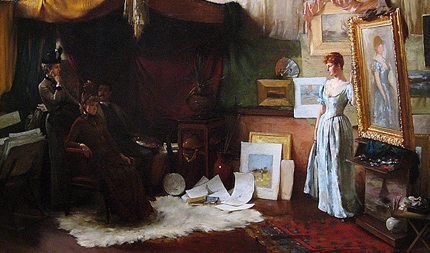
As a creative professional, I assume you are already very creative.
Whatever stage you’re at in your career, you have experience of coming up with original ideas and turning them into outstanding work. So I won’t waste your time by telling you to ‘think outside the box’ or any of that nonsense.
What I will do is remind you of a few things you already know, and nudge you to take them further, by constantly challenging yourself to do better and better work.
Developing your creative talent is an ongoing process involving three interlocking activities:
- Be a sponge — absorb information and influences from outstanding creators in your field.
- Practise, practise, practise — you’ll never reach perfection, but this will get you closer.
- Get great feedback — and make good use of it.
1. Be a sponge
I’m writing this in a room lined with bookshelves, mostly taken up with poetry. The books include all the indisputably great poets from Britain and Ireland since the Middle Ages, plus many of the great American poets and a selection from other cultures, ancient and modern.
I’m a member of the UK Poetry Book Society, who in return for a yearly subscription send me new poetry books as soon as they are published. I subscribe to several poetry magazines and the poetry section is my first stop whenever I visit a bookshop.
This isn’t nearly enough. Compared to the average person I’ve read a lot of poetry, but there are plenty of poets who put my knowledge to shame. I’ve only to walk into the Poetry Library in London — you’ve guessed it, an entire library full of nothing but poetry — to realise how many more poems have been written than I’ll ever have time to read.
This used to make me anxious. These days, I know it makes me lucky. It means I’ll never run out of new poems to discover and new things to learn from them about the art of poetry.
If you’re serious about succeeding in your creative field, you’ll have a similar story to tell, and a similar collection of books, discs, data files, images, implements, instruments or whatever. If you don’t yet have a store of knowledge like this, then it’s time to start amassing it. And if you do, then you’ll know it’s never big enough, so the following goes for you too.
Make it your business to know the history of your field, and what’s happening on the scene right now. Whatever your chosen medium, make sure you are constantly reading, watching, listening and learning. Get to know the classic works, even if you think they’re outdated. Pay attention to the avant-garde even if it baffles or enrages you.
Find trusted sources of new material — libraries, websites, specialist shops. Make it easy by finding ways to funnel new content towards you. Subscribe to magazines, blogs, e-mail newsletters. Is there an equivalent of the Poetry Book Society for your field, who will send you the latest works for a subscription?
Look out for ‘human filters’ — critics, editors, bloggers, teachers or knowledgeable friends — people who have their pulse on what’s happening right now and can recommend the good stuff.
Form opinions. Start arguments. Air your views on your blog and see who responds. You don’t have to like everything you come across, but you do need to know about it.
Don’t worry about copying or being too influenced by others’ work. Your talent is stronger than that. And don’t assume you can produce masterpieces without any knowledge of the past masters in your field. Picasso knew the history and rules of art inside out before he blasted them to pieces. If he had to serve his apprenticeship, the chances are you and I do too.
Apart from the pleasure you will get from absorbing all this fabulous work, your knowledge of your field will act like a compost heap, providing rich nourishment for your own creative talent.
Image by mattk1979
2. Practise, practise, practise
‘To practise’ has two meanings: to do something as an exercise, in order to improve your skill; and to do something habitually or in a professional capacity (e.g. to practise law or medicine).
When it comes to creative work, it’s effectively the same thing: even when you’re doing something ‘for real’, such as a commission for a client, to do it well you need to experiment and try something new.
Make it a habit
Opinion is divided over whether a regular routine is an aid to creativity or a constricting straitjacket. Whatever you do, you need to leave room for inspiration, spontaneity and improvisation. But assuming you’re doing that, here are some reasons in favour of practising your art on a daily (or at least weekly) basis:
- The more you work, the faster you will learn, and the better you will get.
- Research has shown that the ratio of masterpieces to average works among professional composers is pretty much constant; the really great ones such as Beethoven, Bach and Mozart produced a higher volume of works overall, and therefore more masterpieces. So your best bet is to produce as much work as possible.
- Routines are great for beating procrastination. If you know you’re supposed to start work at 10, you can’t kid yourself that you’ll do it ‘later’. After a while, a routine becomes a kind of ritual, priming your unconscious mind to produce the creative goods on demand. Remember William Faulkner: “I only write when I am inspired. Fortunately I am inspired at nine o’clock every morning.”
Don’t just put in the hours
Unlike some writers, I don’t write a set number of words a day nor for a set length of time. I know in my gut whether I’ve produced something worthwhile, and I keep going until I get that feeling.
It’s fine to have external markers if you find them helpful, but the most important thing is to put everything into your work each time you do it. Be like the weightlifters who ‘train to fail’ with each set of reps — i.e. until their muscles can no longer lift the weight.
Aim high. Think of your creative heroes. They didn’t just show up and go through the motions each day, they extended their limits by pushing themselves to their limits. They showed that outstanding achievement is humanly possible — and you’re human too.
Push through the Resistance
Steven Pressfield has devoted an entire book to describing and defeating Resistance, the invisible obstacle that arises whenever we commit to “any act that rejects immediate gratification in favour of long-term growth, health, or integrity”.
You won’t be surprised to read the first two items on Pressfield’s list of “activities that most commonly elicit Resistance”:
1. The pursuit of any calling in writing, painting, music, film, dance, or any creative art, however marginal or unconventional.
2. The launching of any entrepreneurial venture or enterprise, for profit or otherwise.
(The War of Art
by Steven Pressfield)
Resistance causes us to procrastinate and neglect our real work. It’s another great reason to get into a regular work habit, since the momentum of a daily routine can help to crush Resistance.
Next time you find yourself procrastinating or resisting the thought of getting down to work, stop for a moment and notice what is happening. Observe your thoughts and feelings. Notice the temptation to go and do something else — anything else — rather than your real work. Recognise that this is just Resistance. It’s an occupational hazard for creative people — as Pressfield says, you turn pro when you see Resistance for what it is, stare into its eyes, and start work regardless.
If you find yourself defeated in a head-on confrontation with Resistance, here’s a sneakier way round it, courtesy of Mark Forster in his book Do It Tomorrow: tell yourself “I’m not really going to start work right now, I’m just going to get my equipment out and look at it.” For some reason, this seems to short-circuit something in the brain connected with Resistance, and before you know it you’ll find yourself starting to tinker with things and becoming absorbed in the task …
3. Get good great feedback

It doesn’t matter how much you know, or how hard you work, it’s impossible to become really good at something without feedback. And it’s notoriously difficult to evaluate your own creative work, which makes it essential to find critics you can trust.
Distinguish between criticism and negativity
Criticism has a bad rap, but it’s only clumsy or malicious criticism, a.k.a. negativity that you need to watch out for. Ignore the people who come out with it.
Constructive criticism is not a contradiction in terms — if you find someone with informed critical judgement who is prepared to give you an honest but supportive critique of your work, jump at the chance.
Choose your critics carefully
Of course it’s nice if your family and friends like your work, but most of the time they’re not going to be much help to you professionally. Here are four classes of people you should pay attention to — selectively. i.e. by listening to the ones who have valid points to make and/or your best interests at heart.
- A mentor — an experienced practitioner who has taken you under his or her wing. A good mentor will get to know you and your work well enough to help you find your own path and let you know when you’re following it or straying away from it.
- Your peers — if you can get over the competitive element, your fellow practitioners can be a great source of feedback, since they will be facing many of the same problems and opportunities as you. And don’t forget to return the favour — you can hold a mirror up to each other’s creative practice.
- The critics — don’t just dismiss them. Sure, some of them have their own agendas and are best ignored, but some will have interesting and valuable things to say about your work, even if they don’t sugar the pill!
- Your audience — this is arguably your final court of appeal. These are the people who buy your work (or don’t), come to your shows (or don’t) and sing your praises (or don’t). Beware of pandering to the crowd, but pay attention to them.
Don’t take it personally
OK, I know this is easier said than done! To a certain degree, you have to take it personally — if you don’t put your heart and soul into your work, it won’t be any good, so you can’t just take the heart and soul out again afterwards.
But if you’re going to learn and improve, you’ll have to grow a thicker skin, or at least get used to the jabs of criticism. It’s one more thing that separates out the amateur from the professional. Read my articles Three Ways to Assess Your Own Creative Work and 6 Tips for Dealing with Feedback on Your Creative Work for some ways to do this.
Do something with the feedback
There’s no point going through all the pain and stress of soliciting feedback if you just ignore it. That doesn’t mean you implement every suggested change. It’s perfectly okay to consider criticism and then set it aside.
Alternatively, you could experiment by trying out some new options based on the feedback you’ve received. You may not like the results and you’re always free to go back to the original, but at least the critic will have shown you your work from a new perspective — and exploring different perspectives is at the heart of creativity, as we’ll see in next week’s lesson …
Worksheet
Podcast episodes
The following episodes of The 21st Century Creative Podcast touch on the themes of today’s lesson:
Poetry as Discovery with Mimi Khalvati
Tyler Hobbs – an Artist Who Paints with Code
Truth and Fiction with Steven Pressfield
Javier Weyler: A Journey into Sound
Storytelling – a Matter of Life and Death with CJ Lyons
The Art of Not Falling Apart with Christina Patterson
How to Find the Heart to Start with David Kadavy
Other resources
Written by me, unless otherwise indicated
1. Be a sponge
What Do Your Possessions Say about Your Creative Obsessions?
Kabuki: Learning from 400 Years of Creative Tradition
A Simple System to Help You Finish (and Abandon) More Books
2. Practise, practise, practise
Daily Rituals: How Great Minds Make Time, Find Inspiration, and Get to Work by Mason Currey. A great collection of the daily working habits of great artists and thinkers.
Creative Ritual or Mundane Routine?
RSS Creativity – Routines, Systems, Spontaneity
The War of Art: Break Through the Blocks and Win Your Inner Creative Battles by Steven Pressfield
The Creative Habit: Learn It and Use It for Life by Twyal Tharp. Another excellent book about the value of habit and routine in the creative process, by an award-winning dancer and choreographer.
How to Be Creative by Hugh MacLeod. A hugely popular article by a cartoonist-entrepreneur, that expanded into his book Ignore Everybody: and 39 Other Keys to Creativity
3. Get great feedback
‘Too Many Notes’: How Not to Give Feedback on Creative Work
5 Tips for Giving Feedback on Creative Work
What Seamus Heaney Taught Me about Giving Feedback
6 Tips for Dealing with Feedback on Your Creative Work
Three Ways to Assess Your Own Creative Work
Be Thankful for Your Inner Critic
Why Critical Thinking Is Not a Creativity Killer
Tune in next week …
… when I’ll help you develop your creative talent by looking at the most powerful types of creative thinking.
About The 21st Century Creative
Copyright © Mark McGuinness 2010-2019




